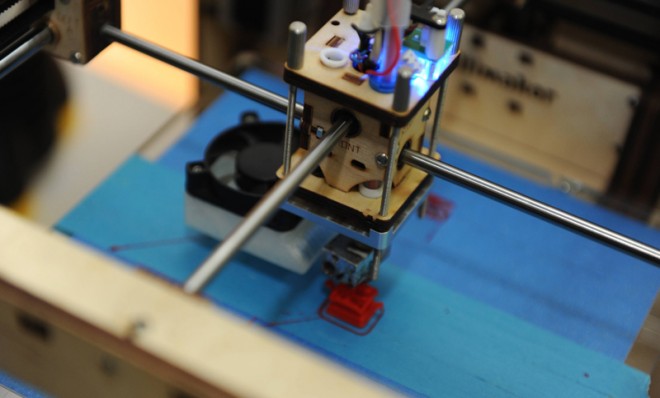Can you 3D print drugs?
The technology exists, and while the hope is to make prescription drug distribution more efficient, there's also a dark side to the novel idea

From the looks of it, 3D printing is about to revolutionize all sorts of industries, from kitchenware (download a design for an ice cube tray off the internet instead of heading to Pier 1 Imports) to dreamier pursuits like the food replicator in Star Trek that we've fantasized about (3D-printed pizza, anyone?). There's the dangerous stuff, too, as Defense Distributed — the libertarian-leaning organization dedicated to disseminating open-source CAD files for 3D-printed handguns and rifles — has demonstrated by thumbing its nose at gun-control laws, irking lawmakers in the process.
Other industries will likely be revolutionized as well, so we might as well ask the hard questions now. How soon until it's possible to 3D print drugs?
Perhaps sooner than you think. Medicine, in particular, was the centerpiece of a recent TED Talk by Lee Cronin, a chemist from the University of Glasgow. Cronin claims to have prototyped a 3D printer capable of assembling chemical compounds on the molecular level. "What Apple did for music," Cronin said, "I'd like to do for the discovery and distribution of prescription drugs."
The Week
Escape your echo chamber. Get the facts behind the news, plus analysis from multiple perspectives.

Sign up for The Week's Free Newsletters
From our morning news briefing to a weekly Good News Newsletter, get the best of The Week delivered directly to your inbox.
From our morning news briefing to a weekly Good News Newsletter, get the best of The Week delivered directly to your inbox.

His process wouldn't be all that different from the way today's clunky 3D printers work, except on a much smaller (and therefore more precise) scale. According to Cronin, users would go to an online drugstore with their digital prescription, buy the "blueprint" and the chemical "ink" they need, and then print the drug at home with software and a 3D molecular printer. Medicine's entire distribution model could, in essence, be flattened.
The advantage, of course, is that the advent of home-printed drugs would open up "the way for personal medicine," Cronin tells Vice. Chemicals and dosages can be tailored to the specific needs of the individual. Allergies and other concerns can be edited out. "In the future, we will not sell drugs, but blueprints or apps," says Cronin.
Granting consumers more control over how they obtain their medicine would have a number of benefits: Localized production would mean the process would be wrested from Big Pharma's multibillion-dollar stranglehold; more consumer freedom would mean lower costs, as well as fewer barriers (physical trips to the doctor when you're sick, etc.) keeping you from the medicine you need to live a comfortable life.
But with all the useful and practical applications of 3D-printed drugs comes an obvious dark side. Take, for instance, the potential for amateur organic chemists to engineer their own designer drugs. In Drugs 2.0: The Web Revolution That's Changing How the World Gets High, author Mike Power envisions a near future where DIYers (mostly college grads with chemistry degrees) are using highly sophisticated techniques — including 3D printers — to render "controlled substances" an obsolete relic of the past. As one book review puts it:
A free daily email with the biggest news stories of the day – and the best features from TheWeek.com
The new designer drugs — or, as the wryly exploratory users' lingo has it, "research chemicals" — are invented by slightly altering the formula for known molecules such as MDMA (ecstasy), ketamine, LSD, and so on. A famous recent example was mephedrone, or "meow meow", cooked up in response to "a global MDMA shortage" after a large quantity of safrole oil (a precursor chemical used to make ecstasy) was seized by the U.N. in Cambodia in 2008. Mephedrone became hugely popular during its window of legality, before the usual fear-mongering denunciations by politicians and the media, and the usual ban. And what does a ban do? As Power argues, it drives users to experiment with another new chemical that is not yet illegal, whose effects might be less well understood. [Disrupt3d]
Today's primitive psychedelics and artificial mood-boosters may be just the beginning, adds The Guardian, as so called "punk chemists" experiment with molecular compounds and report about their effects on their blogs. The chemicals therein may even skirt existing substance-control laws, mucking up the definition of what constitutes a "legal high."
It's dangerous, too — but you didn't need to be told that. As Power argues, the biggest problem with homegrown drugs on file will be the same one that plagues the current illegal drug market: Product mislabeling. (Have you ever downloaded a peer-to-peer file that you thought was one thing, but was in fact something else? Yeah. That.)
As Cronin notes, though, the potential for bringing chemical printers into the home is still a few years away. Nevertheless, a future full of 3D-printed drugs — both legal and illicit — is on the horizon. "Maybe 10 to 15 years? Who knows?" Cronin tells Vice. "Maybe five to 10."
-
 Political cartoons for January 17
Political cartoons for January 17Cartoons Saturday’s political cartoons include hard hats, compliance, and more
-
 Ultimate pasta alla Norma
Ultimate pasta alla NormaThe Week Recommends White miso and eggplant enrich the flavour of this classic pasta dish
-
 Death in Minneapolis: a shooting dividing the US
Death in Minneapolis: a shooting dividing the USIn the Spotlight Federal response to Renee Good’s shooting suggest priority is ‘vilifying Trump’s perceived enemies rather than informing the public’